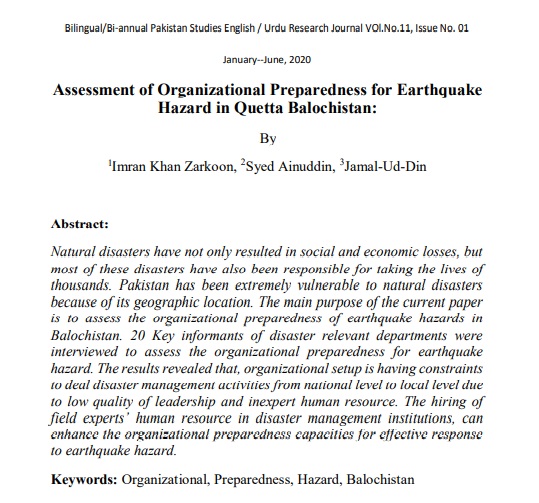Assessment of Organizational Preparedness for Earthquake Hazard in Quetta Balochistan:
Keywords:
Organizational, Preparedness, Hazard, BalochistanAbstract
Natural disasters have not only resulted in social and economic losses, but
most of these disasters have also been responsible for taking the lives of
thousands. Pakistan has been extremely vulnerable to natural disasters
because of its geographic location. The main purpose of the current paper
is to assess the organizational preparedness of earthquake hazards in
Balochistan. 20 Key informants of disaster relevant departments were
interviewed to assess the organizational preparedness for earthquake
hazard. The results revealed that, organizational setup is having constraints
to deal disaster management activities from national level to local level due
to low quality of leadership and inexpert human resource. The hiring of
field experts’ human resource in disaster management institutions, can
enhance the organizational preparedness capacities for effective response
to earthquake hazard.
References
Ahmed, Z., 2013. Disaster risks and disaster management policies and
practices in Pakistan: A critical analysis of the Disaster Management
Act 2010 of Pakistan. International Journal of Disaster Risk
Reduction, 4, pp.15-20.
Ainuddin, S., Routray, J.K. and Ainuddin, S., 2014. People's risk perception
in earthquake-prone Quetta city of Baluchistan. International
Journal of Disaster Risk Reduction, 7, pp.165-175.
Burns, W.J. and Slovic, P., 2012. Risk perception and behaviours:
Anticipating and responding to crises. Risk Analysis, 32(4), pp.579–
Clarke, V. and Braun, V., 2013. Teaching thematic analysis: Overcoming
challenges and developing strategies for effective learning. The
psychologist, 26(2), pp.120-123.
Erduran, E., Magsi, A.M., Gill, A.W.M. and Lindholm, C., 2015.
Earthquake risk assessment of Quetta. Kjeller, Norway, Available
online: http://www. pmd. gov. pk/seismic/3. pdf, Accessed, 26.
Fazl-e-Haider, S., 2013. Calamity-hit Balochistan. [online] Available at:
https://www.dawn.com/news/1047021 [Accessed on 19 Jul. 19]
Galindo, R.P., Villanueva, G.V. and Enguito, M.R.C., 2014. Organizational
preparedness for natural disasters in Ozamiz City,
Philippines. Journal of Multidisciplinary Studies, 3(1).
Guangmeng, G. and Jie, Y., 2013. Three attempts of earthquake prediction
with satellite cloud images. Natural Hazards and Earth System
Sciences, 13(1), pp.91-95.
Joffe, H., Rossetto, T. and Adams, J. eds., 2013. Cities at risk: living with
perils in the 21st Century (Vol. 33). Springer Science & Business
Media.
Maguire, M. and Delahunt, B., 2017. Doing a thematic analysis: A practical,
step-by-step guide for learning and teaching scholars. AISHE-J: The
All Ireland Journal of Teaching and Learning in Higher
Education, 9(3).
Myers, J., 2016. Which natural disasters hit most frequently? [online]
Available at: https://www.weforum.org/agenda/2016/01/whichnatural-disasters-hit-most-frequently/ [Accessed on 19 Jul. 19]
NDMA., 2010. About Us. [online] Available at:
http://www.ndma.gov.pk/aboutUs.php [Accessed on 19 Jul. 19]
Petrucci, O., 2012. The impact of natural disasters: simplified procedures
and open problems. In Approaches to Managing Disaster-Assessing
Hazards, Emergencies and Disaster Impacts. IntechOpen.
Rafiq, L. and Blaschke, T., 2012. Disaster risk and vulnerability in Pakistan
at a district level. Geomatics, Natural Hazards and Risk, 3(4),
pp.324-341.
Rehman, S.U., Lindholm, C., Ahmed, N. and Rafi, Z., 2014. Probabilistic
seismic hazard analysis for the city of Quetta, Pakistan. Acta
Geophysica, 62(4), pp.737-761.
Sadiq, A.A. and Graham, J.D., 2016. Exploring the predictors of
organizational preparedness for natural disasters. Risk
analysis, 36(5), pp.1040-1053.
Soiferman, L.K., 2010. Compare and Contrast Inductive and Deductive
Research Approaches. Online Submission.



